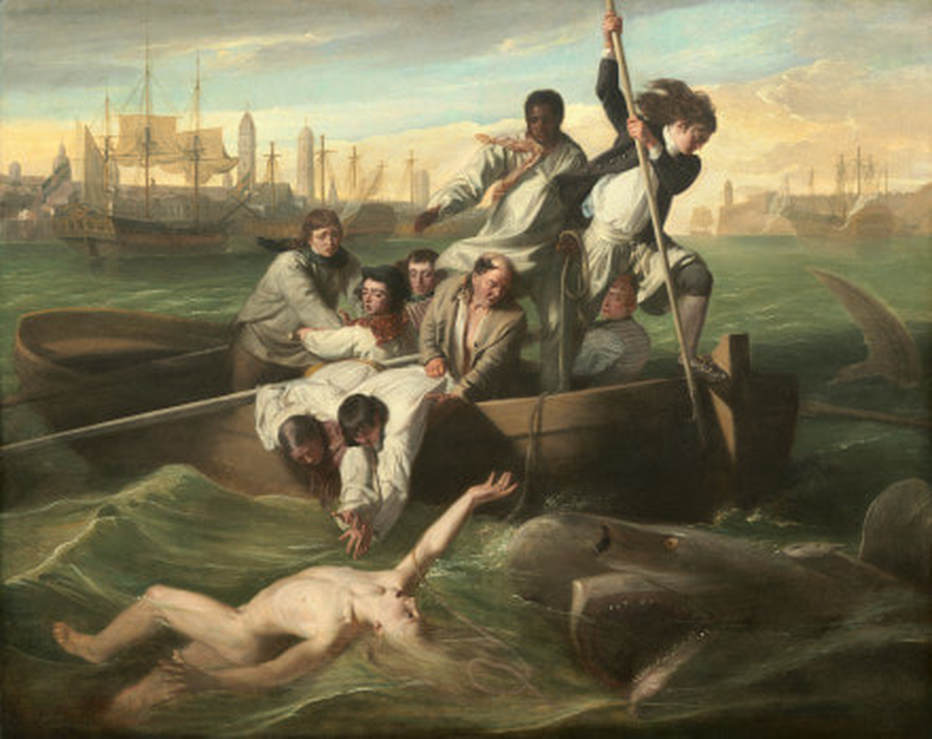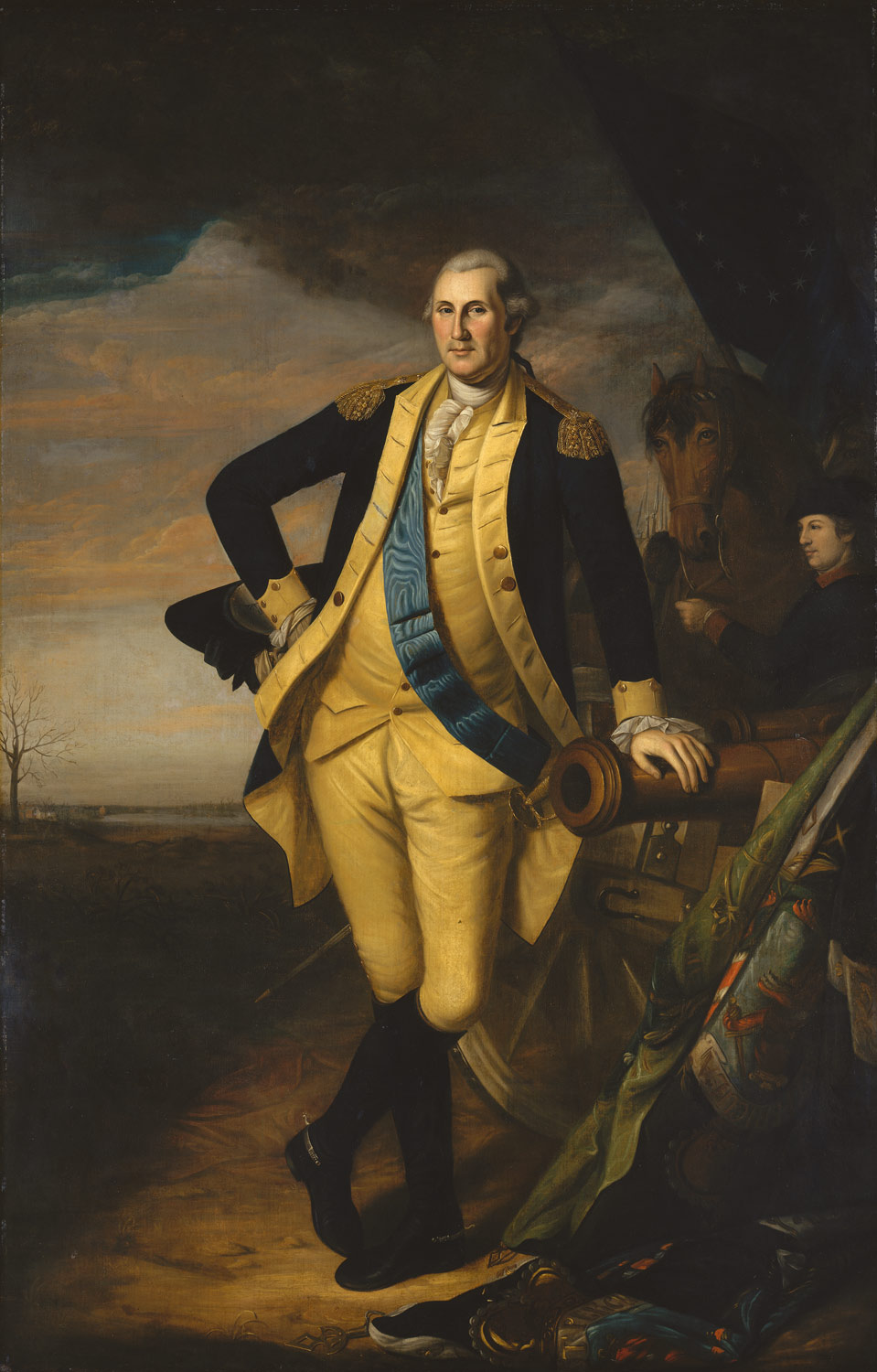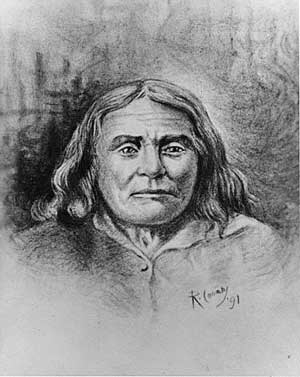WATSON AND THE SHARK BY JOHN COPELY

This will be our first class Wayback Wednesday. Lets take the time machine to the beginning of the American nation.
Watson and the Shark was inspired by an event that took place in Havana, Cuba, in 1749. Fourteen-year-old Brook Watson, an orphan serving as a crew member on a trading ship, was attacked by a shark while swimming alone in the harbor. His shipmates, who had been waiting on board to escort their captain ashore, launched a valiant rescue effort.
Copley chose to depict the moment of highest dramatic intensity -- the instant just prior to the third, presumably fatal, attack. Viewers had no way of knowing that the lad would be plucked from the jaws of death by his stalwart companions.
Brook Watson, a young sailor out for a swim, was attacked by a shark and saved by his shipmates. The shark bit off part of Watson's leg, but he recovered and went on to live a well-documented, one-legged life as a merchant and politician in London, and eventually served a term as mayor from 1796-97. It is likely that Watson commissioned the painting from Copley.
“Was it not for preserving the resemblance of particular persons,” Copley complained about colonial America, “painting would not be known in the place.” He dreamed of working in England’s more cosmopolitan artistic environment and of making “history paintings,” those images of religious, mythological, or historical events that were traditionally considered the apex of artistic achievement. In 1774 Copley left America and began a forty-year career in London. Watson and the Shark, his first large-scale history painting, depicts the heroic rescue of English merchant Brook Watson (1735–1807) who, as a young cabin boy, lost a leg to a shark while swimming in the harbor of Havana, Cuba. Watson and the Shark is an astonishing achievement for an artist who had previously painted only portraits.[citations used below]
Research:
Watson and the Shark was inspired by an event that took place in Havana, Cuba, in 1749. Fourteen-year-old Brook Watson, an orphan serving as a crew member on a trading ship, was attacked by a shark while swimming alone in the harbor. His shipmates, who had been waiting on board to escort their captain ashore, launched a valiant rescue effort.
Copley chose to depict the moment of highest dramatic intensity -- the instant just prior to the third, presumably fatal, attack. Viewers had no way of knowing that the lad would be plucked from the jaws of death by his stalwart companions.
Brook Watson, a young sailor out for a swim, was attacked by a shark and saved by his shipmates. The shark bit off part of Watson's leg, but he recovered and went on to live a well-documented, one-legged life as a merchant and politician in London, and eventually served a term as mayor from 1796-97. It is likely that Watson commissioned the painting from Copley.
“Was it not for preserving the resemblance of particular persons,” Copley complained about colonial America, “painting would not be known in the place.” He dreamed of working in England’s more cosmopolitan artistic environment and of making “history paintings,” those images of religious, mythological, or historical events that were traditionally considered the apex of artistic achievement. In 1774 Copley left America and began a forty-year career in London. Watson and the Shark, his first large-scale history painting, depicts the heroic rescue of English merchant Brook Watson (1735–1807) who, as a young cabin boy, lost a leg to a shark while swimming in the harbor of Havana, Cuba. Watson and the Shark is an astonishing achievement for an artist who had previously painted only portraits.[citations used below]
Research:
- https://www.youtube.com/watch?v=RP-H-NG-8Lg
- http://www.nga.gov/content/ngaweb/Collection/highlights/highlight46471.html
- https://www.nga.gov/feature/watson/story1.shtm
- http://www.artbabble.org/video/ngadc/watson-and-shark-1778-john-singleton-copley
- http://www.csmonitor.com/1989/0214/ushark.html
- http://smarthistory.org/copley-watson-and-the-shark/
- http://www.mfa.org/collections/object/watson-and-the-shark-30998
National Gallery excerpts Washington D.C.
The Watson and the Shark web feature was written, designed, and produced by Donna Mann, senior publications manager, education publications. Anne Zapletal, staff assistant, education publications obtained the photo permissions.
Photo credits for non-NGA images:
The Watson and the Shark web feature was written, designed, and produced by Donna Mann, senior publications manager, education publications. Anne Zapletal, staff assistant, education publications obtained the photo permissions.
Photo credits for non-NGA images:
- Schelte Adams à Bolswert (1586-1659), Miraculous Draught of Fishes, engraving, 55.2 x 84.4 cm, The Harvard University Art Museums, Gift of Belinda L. Randall from the collection of John Witt Randall, Photograph © President and Fellows, Harvard College, Harvard University Art Museums.
- Engraved by Peter Canot, drawn by Elias Durnford, published by Thomas Jeffreys, A view of the Entrance of the Harbour of the Havana taken from within the Wrecks, published August 1764, Photograph courtesy of the Library of Congress.
- John Singleton Copley, The Ascension, 1775, oil on canvas, Museum of Fine Arts, Boston, Photograph © 1996 The Museum of Fine Arts, Boston.
- John Singleton Copley, Boy with Squirrel (Henry Pelham), 1765, oil on canvas, 30 1/4 x 25 in, Museum of Fine Arts, Boston, Anonymous gift, Photograph © 1996 The Museum of Fine Arts, Boston.
- John Singleton Copley, Head of a Negro, 1777/1778, oil on canvas, 53.3 x 41.3 cm, The Detroit Institute of Arts, Founders Society Purchase, Gibbs-Williams Fund, Photograph © 1986 The Detroit Institute of Fine Arts.
- John Singleton Copley, Rescue Group, middle 18th/early 19th century, black chalk heightened with white, squared for transfer in red chalk, The Detroit Institute of Fine Arts, City of Detroit Purchase, Photograph © The Detroit Institute of Fine Arts 1994.
- John Singleton Copley, Study of a Head (Brook Watson), black and white chalk on gray-blue paper, 14 3/16 x 22 9/16 in, The Museum of Fine Arts, Boston, Gift of Thomas Inglis, Photograph © 1996 The Museum of Fine Arts, Boston.
- John Singleton Copley, Watson and the Shark, 1778, oil on canvas, 72 x 90 1/4 in, The Museum of Fine Arts, Boston, Gift of Mrs. George von Lengerke Meyer, Photograph © 1996 The Museum of Fine Arts, Boston.
- John Singleton Copley, Watson and the Shark, 1777-1778, oil on canvas, 91.4 x 77.5 cm, The Detroit Institute of Arts, Founders Society Purchase, Dexter M. Ferry Jr. Fund, Photograph © The Detroit Institute of Fine Arts.
- Robert Dighton, Brook Watson, 1803, hand-colored etching on laid paper, 25.2 x 15.2 cm, Webster Canadian Collection, New Brunswick Museum, Saint John, N.B.
- Sir Nicholas Dorigny, Miraculous Draught of Fishes, engraving, 51.3 x 61.6 cm, The Harvard University Art Museums, Gift of William Gray from the collection of Francis Calley Gray, Photograph © President and Fellows, Harvard College, Harvard University Art Museums.
- Valentine Green after John Singleton Copley, Youth Saved from a Shark, 1779, mezzotint, 50.9 x 60.9 cm, Webster Canadian Collection, New Brunswick Museum, Saint John, N.B.
- Charles Le Brun, Dread, Astonishment, Contempt, three engravings from Conférence de M. Le Brun sur l'expression générale et particulière, Paris, E. Picard, 1698.
- Raphael, Transfiguration, 1517-1520, oil on panel, Pinacoteca, Vatican Museums, Vatican State, Photograph courtesy of Scala/Art Resource, New York.
- Roman, Borghese Gladiator, 1st century A.D. copy from 1st3rd century B.C., marble, height 199 cm, Museacute;e du Louvre, Paris, Photograph © by Erich Lessing/Art Resource, New York.
- Laöcoon, probably 1st century after Hellenistic or Roman original, 1.84 meters, marble, Museo Pio Clementino. Vatican Museums, Vatican State, Photograph courtesy of Scala/Art Resource, New York.
- James Sayer, Brook Watson, 1788, etching on laid paper, 17.6 x 11.1 cm, Webster Canadian Collection, New Brunswick Museum, Saint John, N.B.
- Phillippe-Joseph Tassaert after Rubens, Jonah Thrown into the Sea, 18th century after original painting of 16181619, etching and engraving, The Metropolitan Museum of Art, New York, The Elisha Whittelsey Collection, The Elisha Whittelsey Fund, 1951 (51.501.7003). All rights reserved, The Metropolitan Museum of Art.
- Benjamin West, Agrippina Landing at Brundisium with the Ashes of Germanicus, 1768, oil on canvas, Yale University Art Gallery.
- Benjamin West, The Death of General Wolfe, 1770, oil on canvas, 152.6 x 214.5 cm, National Gallery of Canada, Ottawa, Transfer from the Canadian War Memorials, 1921 (Gift of the 2nd Duke of Westminster, Eaton Hall, Cheshire, 1918).
- Photograph of a tiger sand shark by George Grall, © National Aquarium, Baltimore.
Teaching hard HistoryWe have a responsibility to make our nation’s racial history visible, and an opportunity to do so. Teachers need well-constructed tools, well-curated materials, guidance and professional development to deal with this sensitive and charged topic. More importantly, they need the courage that can only come with a national call to teach this history.[SPLC]
https://www.humanitiesforwisdom.org/awful-slavery.html https://www.humanitiesforwisdom.org/mrcs-blog/while-cotton-was-king-how-was-it-for-free-blacks Jelani Cobb-Carson on immigrants https://www.newyorker.com/news/daily-comment/ben-carson-donald-trump-and-the-misuse-of-american-history |
Slavery MAtters lecture
Professor Walvin Sept. 25, 2019 James Walvin, professor emeritus at the University of York and the Los Angeles Times Distinguished Fellow at The Huntington, discusses the widespread global ramifications of African slavery that transformed the cultural habits of millions of people. We will be looking at a slide deck soon after the American Revolution Workshop. https://www.huntington.org/videos-recorded-programs/slavery-matters |
Who We Are |
Lorem ipsum dolor sit amet, consectetur adipiscing elit, sed do eiusmod tempor incididunt ut labore et dolore magna aliqua. Ut enim ad minim veniam, quis nostrud exercitation ullamco laboris nisi ut aliquip ex ea commodo consequat. Duis aute irure dolor in reprehenderit in voluptate velit esse cillum dolore eu fugiat nulla pariatur. Excepteur sint occaecat cupidatat non proident, sunt in culpa qui officia deserunt mollit anim id est laborum.
|
Our History |
Lorem ipsum dolor sit amet, consectetur adipiscing elit, sed do eiusmod tempor incididunt ut labore et dolore magna aliqua. Ut enim ad minim veniam, quis nostrud exercitation ullamco laboris nisi ut aliquip ex ea commodo consequat. Duis aute irure dolor in reprehenderit in voluptate velit esse cillum dolore eu fugiat nulla pariatur. Excepteur sint occaecat cupidatat non proident, sunt in culpa qui officia deserunt mollit anim id est laborum.
|







